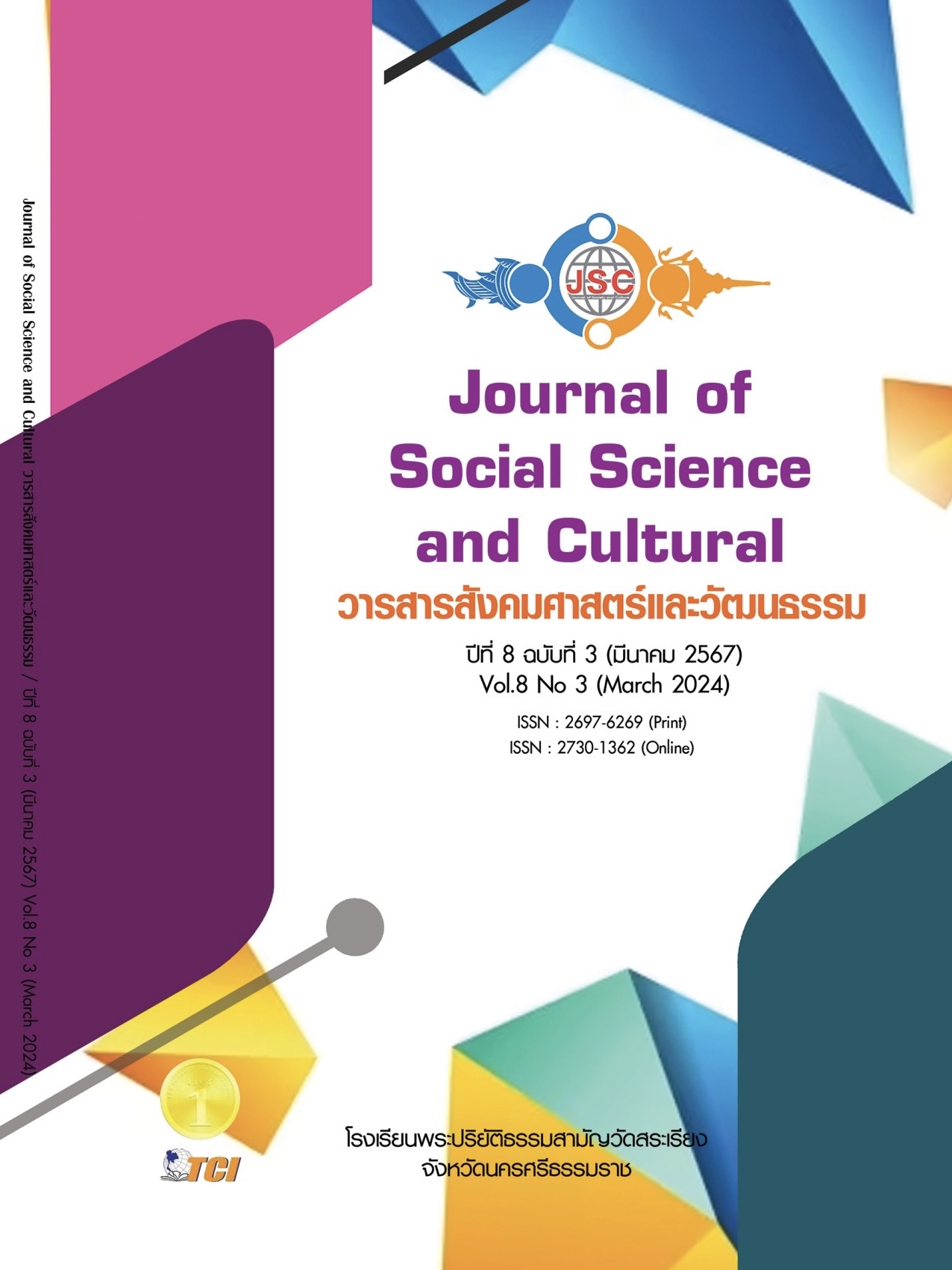COMMUNICATION COMPETENCY DEVELOPMENT OF MAYOR OF SUBDISTRICT MUNICIPALITY
Main Article Content
Abstract
This research aims to study 1) the components of communication competency utilized by subdistrict municipal mayors in performing their duties. 2) factors including personal characteristics, knowledge and attitudes, communication patterns, and personal integrity that correlate with the communication competency of subdistrict municipal mayors. The research employs a mixed-methods approach, starting with qualitative research by collecting data from subdistrict municipal mayors who have held their positions continuously for at least 8 years, totaling 15 individuals, using purposive sampling and conducting in-depth interviews with a semi-structured interview guideline to analyze foundational and significant content. Subsequently, quantitative research was conducted by gathering data from 225 subdistrict municipal mayors using cluster random sampling from 5 regions of Thailand. A validated questionnaire was employed, and statistical analysis including descriptive statistics, correlation analysis, and the chi-square test were utilized. The research findings reveal that there are seven components of communication competence utilized by sub-district municipality mayors in their duties, namely: 1.1) Speaking and Presentation, 1.2) Listening, 1.3) Personality, 1.4) Relationship Building with the Public, 1.5) Image Building, 1.6) Communication Channel Establishment, and 1.7) Utilization of Modern Communication Technology. Statistical analysis indicates significant correlations (at the 0.01 and 0.05 levels) between communication competence and factors such as general characteristics, knowledge and attitude, communication patterns, and personal attributes. This suggests that the most effective performance of duties requires the utilization of all seven communication competencies, in conjunction with self-derived and external factors.
Article Details
References
กรมส่งเสริมการปกครองส่วนท้องถิ่น. (2560). ยุทธศาสตร์กรมส่งเสริมการปกครองท้องถิ่น พ.ศ. 2560 - 2569 กลุ่มงานยุทธศาสตร์และนโยบาย กองยุทธศาสตร์และแผนงาน. เรียกใช้เมื่อ 25 มกราคม 2567 จาก https://www.dla.go.th/visit/stategics.pdf
ณัฐวัฒน์ สิริพรวุฒิ. (2560). การจัดการภาครัฐแนวใหม่ในการบริหารองค์การปกครองท้องถิ่น : กรณีเทศบาลในจังหวัดสิงห์บุรี. วารสารสมาคมนักวิจัย, 18(1), 90-96.
นิชาวดี ตานีเห็ง และคณะ. (2562). สมรรถนะการสื่อสารของนายกองค์การบริหารส่วนตำบลในสามจังหวัดชายแดนภาคใต้. วารสารอัลฮิกมะฮฺ มหาวิทยาลัยฟาฏอนี, 9(17), 105-114.
บุญส่ง ทิ้งชั่ว และคณะ. (2564). รูปแบบการสื่อสารเพื่อการมีส่วนร่วมในการกำหนดนโยบายพัฒนา ตำบลนาโพธิ์ อำเภอกุสุมาลย์ จังหวัดสกลนคร. วารสารการบริหารการปกครองและนวัตกรรมท้องถิ่น, 5(2), 89-104.
พรรณภา ส่งแสงแก้ว. (2566). การพัฒนากรอบความคิดแบบเติบโต ในทักษะการสื่อสารด้านการพูดเพื่อการนำเสนอ. ใน รายงานวิจัย. มหาวิทยาลัยศรีปทุม.
รัตนา เพ็ชรสูงเนิน. (2561). คุณลักษณะของผู้นำเทศบาลที่ประสบความสำเร็จในการบริหารจัดการบ้านเมืองที่ดี. มหาวิทยาลัยธรรมศาสตร์: กรุงเทพมหานคร.
วัชราภรณ์ กลิ่นภู และคณะ. (2561). การส่งเสริมการใช้เทคโนโลยีสารสนเทศเพื่อการบริหารงานของเทศบาลบางบัวทอง จังหวัดนนทบุรี. วารสารวิชาการ สถาบันวิทยาการจัดการแปซิฟิก, 4(1), 279-285.
เอกรัตน์ คำสิงห์ และคณะ. (2564). กลยุทธ์การใช้สื่อในการสื่อสารผลงานของนายกเทศมนตรีตำบลท่าก้อน อำเภออากาศอำนวย จังหวัดสกลนคร. วารสารการบริหารการปกครองและนวัตกรรมท้องถิ่น, 5(2), 149-168.
Batırlık, S. N. et al. (2022). Global virtual team leadership scale (GVTLS) development in multinational companies. Sustainability, 14(2), 1038. https://doi.org/10.3390/su14021038.
Clayton, W. (2020). Connecting Mayors: The Content and Formation of Twitter Information Networks. Urban Affairs Review, 58(1), 33-67.
Deborah, J. B. (2010). Leadership Communication (3rd ed). New York: McGraw-Hill Companies.
Fayzullayeva, N. (2023). The improving of listening skill. Modern Science and Research, 2(10), 272-276.
Juwito, J. et al. (2022). Public speaking and personal branding skills for student organization managers at Dharma Wanita High School Surabaya. Journal of Community Service and Empowerment, 3(1), 9-17.
Krejcie, R. V. & Morgan, D. W. (1970). Determining Sample Size for Research Activities. Educational Psychological Measurement, 30, 607-610. https://doi.org/10.1177/001316447003000308.
Lee, Y. (2022). Personality traits and organizational leaders' communication practices in the United States: perspectives of leaders and followers. Corporate Communications: An International Journal, 27(3), 595-615.
Mitchell, T. et al. (2022). Inclined but less skilled? Disentangling extraversion, communication skill and leadership emergence. Journal of Applied Psychology, 107(9), 1524. https://doi.org/10.1037 /apl0000962 .
Nieken, P. (2023). Charisma in the gig economy: The impact of digital leadership and communication channels on performance. The Leadership Quarterly, 34(6), 101631. https://doi.org/10.1016/ j.leaqua.2022.101631.
Owens, A. D. & Hite, R. L. (2022). Enhancing student communication competencies in STEM using virtual global collaboration project based learning. Research in Science & Technological Education, 40(1), 76-102.
Rangarajan, D. et al. (2017). Strategic personal branding—And how it pays off. Business Horizons, 60(5), 657-666.
Schulze, J. et al. (2022). Mind the context-The relevance of personality for face-to-face and computer-mediated communication. Plos one, 17(8), e0272938. https://doi.org/10.1371/journal. pone.0272938.
Trenholm, S. & Jensen, A. (2000). Interpersonal communication (4th ed.). California: Wadsworth Publishing Company.
Wanithanachakorn, R. et al. (2022). Development of causal relationship model of factors affecting communicative English listening and speaking competency for undergraduate students of Rajabhat universities in the central region. Journal of MCU Nakhondhat, 9(9), 314-327.
Yamane, T. (1973). Statistics: An Introductory Analysis (3th ed.). Harper and Row: New York.


